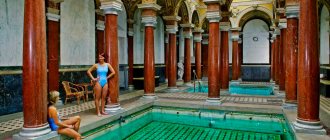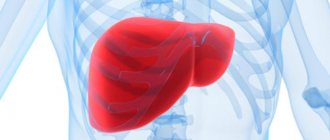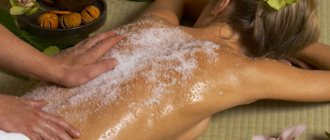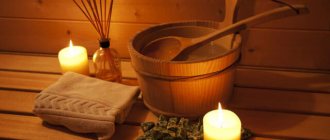Photo from the website clubsaun.ru The Turkish hammam steam room is one of the most useful and popular options for sauna relaxation in the whole world. This is where you can restore strength to those who are tired of constant stress and everyday hustle and bustle, get a powerful boost of energy, relax a little, get distracted and relieve physical fatigue. After all, this is not just a bathhouse, but a certain ritual and a whole philosophy, which is based not only on complete physical, but also spiritual cleansing.
Let's figure out what a Turkish bath is, how often you can visit it, and what is better: a hammam or a sauna.
Turkish steam room: what is it?
The first Turkish baths began to be built in the 7th century. Classic hammams are large buildings with several rooms, each of which maintains a certain level of humidity and temperature.
Photo from cocoony-domicile.fr
Such saunas are built according to the “palm” principle - there are several small rooms around the main steam room:
- Jamekian is a locker room where all visitors leave everything they need (clothes, shoes, belongings) and put on a loincloth made only from absolutely natural materials (cotton or silk fabric).
- Pestemal is a place where guests take a shower.
- Chebek is a room where you can warm up your body on a hot lounger, which is made of natural marble (“chebek-tashi”). It is quite comfortable to sit on it for a long time.
- Hararet is a steam room designed for deep cleansing of the skin. Here they perform intense foam and oil massage and peeling.
- A cafe is a room in which, after all procedures, one rests, eats or drinks healing herbal teas.
Hamam architecture
The hammam is built according to the palm principle, that is, in plan the room is a structure that consists of five rays emerging from one center - niches (eivans).
The oldest hamams were built by the Umayyad caliphs, who ruled the Arab Caliphate from 661 to 750 and lived a Bedouin lifestyle. Therefore, the first baths appeared not in cities, but in the wild desert. Kusair-aman, one of the oldest hammams that have survived to this day, unexpectedly opened up to the gaze of a traveler in the middle of a waterless desert on the shores of the Dead Sea, surrounded by a blooming garden.
This oasis once also housed a castle for arriving guests and a watchtower, the ruins of which are now almost razed to the ground.
With the spread of Islam, hamams appeared in Iraq, Central Asia, and North Africa (from Egypt to Morocco). During the period of Arab rule in Spain, many eastern baths were built there, and very often castle towers, palaces, and churches were rebuilt for these purposes. The number of hammams compared to the size and density of the then population was truly enormous. In the 9th century, there were 5,000 baths in the eastern part of Baghdad alone. There were 10,000 baths throughout Baghdad already in the first half of the 10th century. Later, the number of hamams began to decline mainly due to their qualitative changes. In the second half of the century, there were reportedly again "only" 5,000. Later, the number of baths steadily decreased, and in the 12th century there were only 2,000 left. The same thing happened in Egypt: in Old Cairo there were about 1,170 hot baths, and in New Cairo in 1286 only 80.
By this time, a specific architectural style of the hammam had formed. Many buildings are luxuriously decorated with mosaics; the interiors often have fountains and pools with water of varying temperatures. The Muslim ban on the depiction of living creatures contributed to the appearance of oriental ornaments, stunning in their ghostly and mysterious beauty, which abundantly decorated the entrance and interior of hammams.
In many regions, following the example of the Romans, the Arabs built hammams at hot springs. They were called kaplika, or ilika. There was no stone pedestal for massage in their hot rooms. The room was heated with water from springs. The oldest kaplikas and ilikas in the East are located in the city of Bursa.
Features of the Turkish steam room
Hamam differs from Russian and Finnish baths in that all rooms in it are heated using a boiler placed under the floor covering or built into one of the walls. The steam generated in it is supplied through several small holes, which are located at a height of approximately 1.5 meters.
The interior of a modern oriental bathhouse is always made almost entirely of stone, mosaic or tile. Wood is not even used to decorate sun loungers. The ceiling of the steam room has a dome shape. This is done so that condensation does not drip from it and does not disturb visitors, but flows down the walls.
Who should not take a steam bath in the hammam?
There are special groups of people who are prohibited from taking a steam bath in a Turkish hammam.
- With cancer. People steaming in the hammam accelerate blood circulation, so tumor particles and toxins quickly spread throughout the body.
- Having mental disorders. The hot temperatures of the hammam provoke an increase in aggression.
- With skin and fungal diseases. Such diseases can be aggravated by staying in the humid, warm climate of the hammam.
- With severe lung diseases. Humid air is difficult to inhale, especially if your lungs are not working at full capacity. A person with such diseases may begin to choke.
- With viral, infectious diseases, any inflammation.
People with cardiovascular diseases should be especially careful when staying in the hammam: reduce the time spent in the steam room to half an hour, and do not use the pool after the procedures.
Important! The beneficial properties of hammam have been proven for diseases at the recovery stage: bronchitis, sinusitis, colds. The main rule is the absence of elevated body temperature.
Hammam: visiting rules
Photo from the website golden-hammam.ua
To get only pleasant emotions and maximum health benefits from visiting a hamam, you need to know how to go to a Turkish bath correctly: how to steam in a chebek, use peelings or cosmetics, and how long you need to stay in the harare.
First of all, before starting various massage procedures, you should sweat thoroughly. To do this, lie down or sit on a lounger for 20-30 minutes, which is previously covered with a cloth. The body is steamed, and all the pores are opened, so after about 30 minutes you need to start various types of massage. In a real Turkish bath he is quite energetic and sometimes even tough. Strong movements accelerate the blood, rub the whole body, which allows you to restore flexibility to the joints and stretch the muscles well.
Photo from the site m.slovenskenovice.si
After such manual therapy, you can lie down and relax for a while, or you can do peeling. To do this, use a hard glove to cleanse all dead and keratinized particles from the skin. The stage following peeling is a light soap massage. A bar of regular soap is placed in a mesh bag and shaken a little, resulting in a thick and soft foam. They cover the visitor from head to toe, and then begin to massage. After this, you can go to the relaxation room - there everyone will be offered to relax and drink a cup of herbal tea.
It is important to follow these recommendations:
- While visiting the hammam, it is prohibited to drink any alcohol or drink very cold drinks.
- It is better to limit yourself to tea, diluted juices, plain or rose water.
- There is no need to overeat before the bath. Ideally, more than 2 hours should pass after the last meal.
- Never make sudden movements in the steam room. This can be bad for warm muscles, as they are easily damaged in this state.
- It is not customary to go without clothes in such a bathhouse.
What is the difference between pairs?
shutterstock.com
The general principle of such procedures is the effect of high temperatures on the skin and body. Steam rooms differ not only in temperature conditions, but also in air humidity.
- The main attribute of a Russian bath is wet steam: at an air temperature of 50–70°C, humidity reaches the same percentage values. In a Russian bathhouse, there is nowhere for sweat to evaporate: there is not enough temperature, plus high air humidity interferes. In this case, hot steam can have an aggressive effect on the skin, causing dilation of superficial vessels and an intense rush of blood to the skin of the face. For this reason, visiting the bathhouse is not recommended for people with rosacea and sensitive skin.
- In a Turkish hammam, the air temperature does not exceed 40–45 °C, and the humidity reaches 80–90%. The hammam is characterized by a low air temperature and a large amount of moisture, which condenses on surfaces that are less heated than the air. This applies to skin that collects not so much moisture as condensation. This steam room is comfortable for most people due to moderate temperature and high humidity: the skin does not dry out and blood vessels do not dilate. The hammam can be visited by people with sensitive, dry skin and rosacea.
- In a classic sauna, the temperature is 100–120 °C, and the humidity is only 10–15%. These conditions affect the body in different ways. It is easier for a person to be in a sauna: the air contains a lot of oxygen and little moisture. At high temperatures, intense sweat production occurs, which quickly evaporates from the surface of the skin. At the same time, the microclimate is harmful for those with sensitive, dry and couperose skin: dehydration of the body increases.
Visit steam rooms 1-2 times a week if you feel good in hot conditions: regardless of the type of steam room and the intensity of sweating, the body is cleansed of waste and toxins. It also cleanses the pores, exfoliates and softens rough areas of the skin, and moisturizes the skin.
The benefits of a Turkish steam room
Oriental saunas are, first of all, complete relaxation of the body. This means that every visitor will have improved sleep, neuroses, anxiety and severe headaches will disappear. But what else is a Turkish bath useful for women and men? First of all, because it really effectively cleanses the skin, improves metabolic processes and accelerates tissue regeneration. By regularly visiting it, you will slow down the aging process, and using natural oils for massage, you will be able to perfectly moisturize and saturate your skin with useful substances.
Photo from the site aquatec.biz.ua
The benefit of hamam for women and men is also that it helps:
- eliminate stagnant processes in various internal organs;
- normalize blood circulation;
- increase immunity;
- lose excess weight faster;
- get rid of salt deposits;
- improve blood microcirculation in the brain;
- eliminate pain from diseases and inflammation of the joints, as well as diseases of the spine.
It is recommended to visit the hammam even if you have a cold. Steam even helps cure bronchitis, sinusitis, tonsillitis, tracheitis, pneumonia, laryngitis, since warming the body for a long time allows it to more effectively resist various infections. In addition, in hot and humid air, all harmful microorganisms die immediately, so the likelihood of infecting others is zero.
Photo from meydanhamami.com
Sometimes coaches advise athletes to use Turkish baths as often as possible. But what exactly is hammam useful for after a workout? It quickly eliminates pain from muscle pain caused by heavy training by gently and deeply warming them up.
The healing properties of hamam
The healing properties of hamam have been known since ancient times. The great Arab physician, scientist and naturalist, poet and encyclopedist Avicenna (Ibn Sina) considered the bathhouse one of the most powerful means of healing and treatment.
The work of this scientist, “The Canon of Medical Science,” contains a lot of information that is not outdated to this day. A number of recipes and prescriptions are used in modern medicine. Avicenna argued: “If you exercise, lead a healthy lifestyle and don’t forget to go to the bathhouse, there is no need for medicine.” He pointed out the beneficial effects of hammam on blood circulation, breathing, and the ability to lose excess weight. Avicenna recommended a bath for insomnia, paralysis, and nervous disorders. In his opinion, it is indispensable for catarrh of the upper respiratory tract and inflammation of the vocal cords. The bath also helps with gastrointestinal diseases: diarrhea, loss of appetite, indigestion. Dry steam is useful for treating rheumatism. The list of diseases for the treatment of which Avicenna recommends bathing procedures is endless: jaundice and liver swelling, pain in the bladder, kidney stones, pain in the spleen... The scientist also points out contraindications for visiting the hammam: epilepsy, liver blockage, headaches, noise and ringing in the ears. He warns against drinking cold water after a bath and warns that the bath is harmful to vision.
Contraindications to visiting the hammam
It is contraindicated to go to a Turkish bath for those who suffer from:
- cataracts;
- diseases of the endocrine system;
- infectious diseases;
- mental disorders;
- inflammatory processes occurring in internal organs.
Unfortunately, hammam has a negative effect on asthmatics and those with severe lung diseases. Air with high humidity provokes an exacerbation of the disease and the person will begin to choke. Such a sauna can also harm people suffering from any skin diseases. People who have ever been diagnosed with cancer will also be at risk. Due to sufficiently high temperatures, tumor formations can progress.
Photo from guidemarmaris.com
People with hypertension should not go there. It is not so hot in such a steam room, but a sharp increase in pressure is possible. It is not forbidden for pregnant women to go to the hammam, but before visiting it, the expectant mother should ask the attending doctor whether this is possible, since overheating is dangerous in some cases.
For varicose veins, traditional Russian baths are not beneficial. But you can visit the hammam, but only by observing the following precautions:
- In the steam room, lying on a stone lounger, your legs should be slightly raised.
- When sitting on a lounger, your legs should not hang down.
- When cooling down after a massage, you should not stand in one place for a long time; you must move, walking slowly.
In conclusion, I would like to say that Turkish baths are popular all over the world today. You can visit a real oriental sauna at many resorts. Do not deny yourself this pleasure, because it will give you unforgettable impressions and sensations!
Hammam as a center of social life
The hammam, an integral element of the eastern cityscape, was usually built not far from the mosque, but somewhat to the side, in a place hidden from direct view. In the Islamic city he was in every quarter and received his regular visitors every day.
Like the Roman baths, the hammam became the center of public life. “A city is good when it has a bath,” said the early Arab historian Abu Sir. The entrance fee to the hammam was always extremely low, and even the poorest person could afford this pleasure. In the Middle Ages, there was even a custom not to set a specific rate - everyone paid according to their position. By the way, in the hamams of Istanbul today the entrance fee rarely exceeds the equivalent of 3-4 US dollars, and in the Turkish province prices are even lower - up to 1 dollar.
A Turkish bath is not just a place where you can wash your body and improve your health. Hamam has miraculously woven itself into everyday life. Here everyone is equal: rich and poor, young and old, beautiful and unattractive - everyone for some time becomes free from the world that remains outside the walls of the hammam. In old Turkey, women, like men, could visit the bathhouse without restrictions - this was one of the few generally recognized women's rights.











